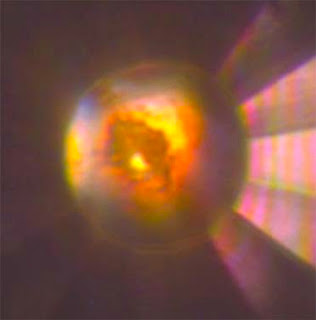Topics: African Americans, History, Diaspora, Diversity in Science, Women in ScienceI present to you two, and by association several "enemies of the state" that addressed their particular eras with the facts, and not the alternative variety. Synopsis
A daughter of slaves, Ida B. Wells was born in Holly Springs, Mississippi, on July 16, 1862. A journalist, Wells led an anti-lynching crusade in the United States in the 1890s, and went on to found and become integral in groups striving for African-American justice. She died in 1931 in Chicago, Illinois.
Early Life
Born a slave in 1862, Ida Bell Wells was the oldest daughter of James and Lizzie Wells. The Wells family, as well as the rest of the slaves of the Confederate states, were decreed free by the Union, about six months after Ida's birth, thanks to the Emancipation Proclamation. However, living in Mississippi as African Americans, they faced racial prejudices and were restricted by discriminatory rules and practices.
Ida B. Wells's parents were active in the Republican Party during Reconstruction. Her father, James, was involved with the Freedman’s Aid Society and helped start Shaw University, a school for the newly freed slaves (now Rust College) and served on the first board of trustees. It was there that Ida B. Wells received her early schooling, but she had to drop out at the age of 16, when tragedy struck her family. Both of her parents and one of her siblings died in a yellow fever outbreak, leaving Wells to care for her other siblings. Ever resourceful, she convinced a nearby country school administrator that she was 18, and landed a job as a teacher.
Journalist and Activist
On one fateful train ride from Memphis to Nashville, in May 1884, Wells reached a personal turning point. Having bought a first-class train ticket to Nashville, she was outraged when the train crew ordered her to move to the car for African Americans, and refused on principle. As she was forcibly removed from the train, she bit one of the men on the hand. Wells sued the railroad, winning a $500 settlement in a circuit court case. However, the decision was later overturned by the Tennessee Supreme Court.
This injustice led Ida B. Wells to pick up a pen to write about issues of race and politics in the South. Using the moniker "Iola," a number of her articles were published in black newspapers and periodicals. Wells eventually became an owner of the Memphis Free Speech and Headlight, and, later, of the Free Speech.
While working as a journalist and publisher, Wells also held a position as a teacher in a segregated public school in Memphis. She became a vocal critic of the condition of blacks only schools in the city. In 1891, she was fired from her job for these attacks. She championed another cause after the murder of a friend and his two business associates.
In 1892, three African-American men—Tom Moss, Calvin McDowell and Will Stewart—set up a grocery store in Memphis. Their new business drew customers away from a white-owned store in the neighborhood, and the white store owner and his supporters clashed with the three men on a few occasions. One night, Moss and the others guarded their store against attack and ended up shooting several of the white vandals. They were arrested and brought to jail, but they didn't have a chance to defend themselves against the charges—a lynch mob took them from their cells and murdered them. [1]
* * * * * |
| Wall Street Journal reporter Daniel Pearl disappeared in the Pakistani port city of Karachi on Jan 23, 2002 after telling his wife he was going to interview an Islamic group leader. AFP/Getty Images |
Bret Stephens delivered the Daniel Pearl Memorial Lecture this week at the University of California, Los Angeles. Read the full text of his remarks below:
I’m profoundly honored to have this opportunity to celebrate the legacy of Danny Pearl, my colleague at The Wall Street Journal.
My topic this evening is intellectual integrity in the age of Donald Trump. I suspect this is a theme that would have resonated with Danny.
When you work at The Wall Street Journal, the coins of the realm are truth and trust — the latter flowing exclusively from the former. When you read a story in the Journal, you do so with the assurance that immense reportorial and editorial effort has been expended to ensure that what you read is factual.
Not probably factual. Not partially factual. Not alternatively factual. I mean fundamentally, comprehensively and exclusively factual. And therefore trustworthy.
This is how we operate. This is how Danny operated. This is how he died, losing his life in an effort to nail down a story.
In the 15 years since Danny’s death, the list of murdered journalists has grown long.
Paul Klebnikov and Anna Politkovskaya in Russia.
Zahra Kazemi and Sattar Behesti in Iran.
Jim Foley and Steve Sotloff in Syria.
Five journalists in Turkey. Twenty-six in Mexico. More than 100 in Iraq.
When we honor Danny, we honor them, too.
We do more than that. [2]
Truth and its pursuit will always be an enemy of the state if that state means ill will to a particular constituency or to violate the precepts of a republic with impunity.
"Ignorance is [not] bliss." [3]
"Ignorance is [not] strength." [4]
Without a free press, the modifier "banana" goes in front of the form of government we enjoy. Despots and demagogues can only accomplish this when a citizenry is either uninformed, lazy, disinterested or nonchalant about the responsibilities of citizenship.
It's really "We The People" ... of the UNITED STATES: To support them, buy a subscription to your local newspaper, a cultural newspaper and a national one. Investigative journalism function well like you and I do, with an infusion of money, lacking in an era of free "point-and-click" and low advertising dollars as print has dwindled to the Internet. Notice I didn't name anyone. That's going to depend on where you are and what your personality leads you to. News feeds on social media don't cut it. You need to sit, digest and question every line. Then, call or write your representatives. Don't TWEET them. They are not part of the generation that reacts to such things (and those social media updates are done in their name by someone on their staffs). They respond to the tied-up switchboard; the mountain of postcards and letters; your physical appearance at Town Halls will eventually move them to action. It's really "We The People"... it's really up to "US."
1. Biography.com: Ida B. Wells2. Time.com: Brett Stephens' remarks, Daniel Pearl Memorial Lecture3. Thomas Gray: Ode on a Distant Prospect of Eton College4. Spark Notes: "1984," by George Orwell














